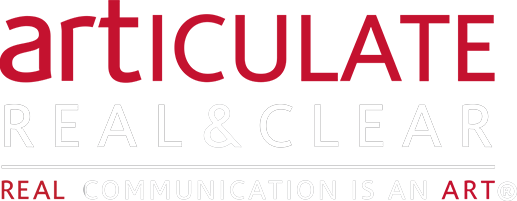Whether you are speaking to a group — or just trying to be heard by your employer, employees, or colleagues—being clear and believable are key to your success.
What sets successful leaders apart from the pack? Simple as it sounds, the answer is: breathing deeply.
We know you’ve heard that many times before—but do you know what it really means? And why it matters so much?
Poor breath use can cause you to present as closed off, inauthentic, and untrustworthy. We’re pretty sure that’s not your intention.
At Articulate Real & Clear, we are committed to helping our clients breathe deeply, speak clearly, and share their authentic message—simply.
After all, crafting your message effectively is complicated enough — so let’s make the voice part easy.
Most of the time, your public speaking voice is just fine.
But then, oddly, only when it really seems to matter in a business transaction or presentation, our voice betrays us.
Our voice is directly connected to our breath and tension. For many reasons, we switch into a different voice and communication style when stressed, or when the situation seems more professional.
Our proper breath use is the key to maintaining our real and authentic voice. That should be easy, right?
After all, we were able to wail loud and clear when we were born. We ran around the playground screaming and shouting when we were kids. And when we’re with our most trusted friends and family, we most certainly laugh out loud. But somewhere along the way, we have lost touch with the ease of speaking in public.
Let’s get down to business.
- Sit up straight (or stand, if you prefer) and release any tension in your shoulders and neck. Tension in your neck area makes your voice sound tight and can make you seem uptight.
- Our breathing is based on a vacuum. Exhale, relax the muscles around the rib cage and feel the expansion sideways as the next breath rushes in. Yes, we are made that way—exhale and let the breath come into the lungs expanding the ribs sideways. Brilliantly simple.
- Warning: Many misleading descriptions and directions have been suggested for years. Like these: Breathe in your belly. Breathe in your stomach. Breathe with your diaphragm.
- Note: You are always breathing in your lungs and your diaphragm is always being used. You can’t actually breathe in your belly, and most business people I know won’t puff out their bellies in public anyway. Use your lungs—breathing is what they’re for! Breathe sideways.
- Being shallow is a choice. Sometimes when people breathe, we see shoulders rise and chests puff out. This is shallow breathing, which only gets air into the top of their lungs. The bad news is that this type of breathing increases tension, not releases it. Again, exhale first, and let the air flow back low and sideways—allowing the ribs to expand to the side and back with the filling of the lungs with breath.
- Watch your breath as you go through the day today. Notice if you are breathing shallowly. This is sometimes called “sipping” or “clavicular” breathing. Stop, exhale, and let the air return deeply into your lungs. See if you feel better.
- Now start talking. Your voice is powered by the exhale. Your words surf on the outflow of air. Deeper breath increases the odds that your voice will be more powerful, too.
Finding the sideways breath:
- Sit down and lean over with your belly pushed against your lap. Feel your breath expand into your sides and back.
- Wrap your arms across your lower chest with your hands on your side ribs. Exhale, and feel the air come back in as the ribs expand.
- Run in place until you are slightly out of breath. Feel the air in your lungs move the ribs.
- Simply think of an athletic endeavor—skiing, biking, softball, fishing, golfing, picking up a child. Most of us will connect with this lower athletic breath if we simply think about engaging in the activity.
- Stand against a wall and imagine breathing into it. Make a connection between your back and the wall.
- Keep a journal of your breath. See if you feel better when you breathe deeply into your lungs. And see if you get a different response when you speak to a few colleagues or friends.
The Bottom Line
Connecting with your deeper breath allows you to have a more authentic voice, and this enables you to engage in trustworthy communication. Understanding the power of your breath is simply good for business.
This article was originally posted on BeInkandescent.com in April 2014.





